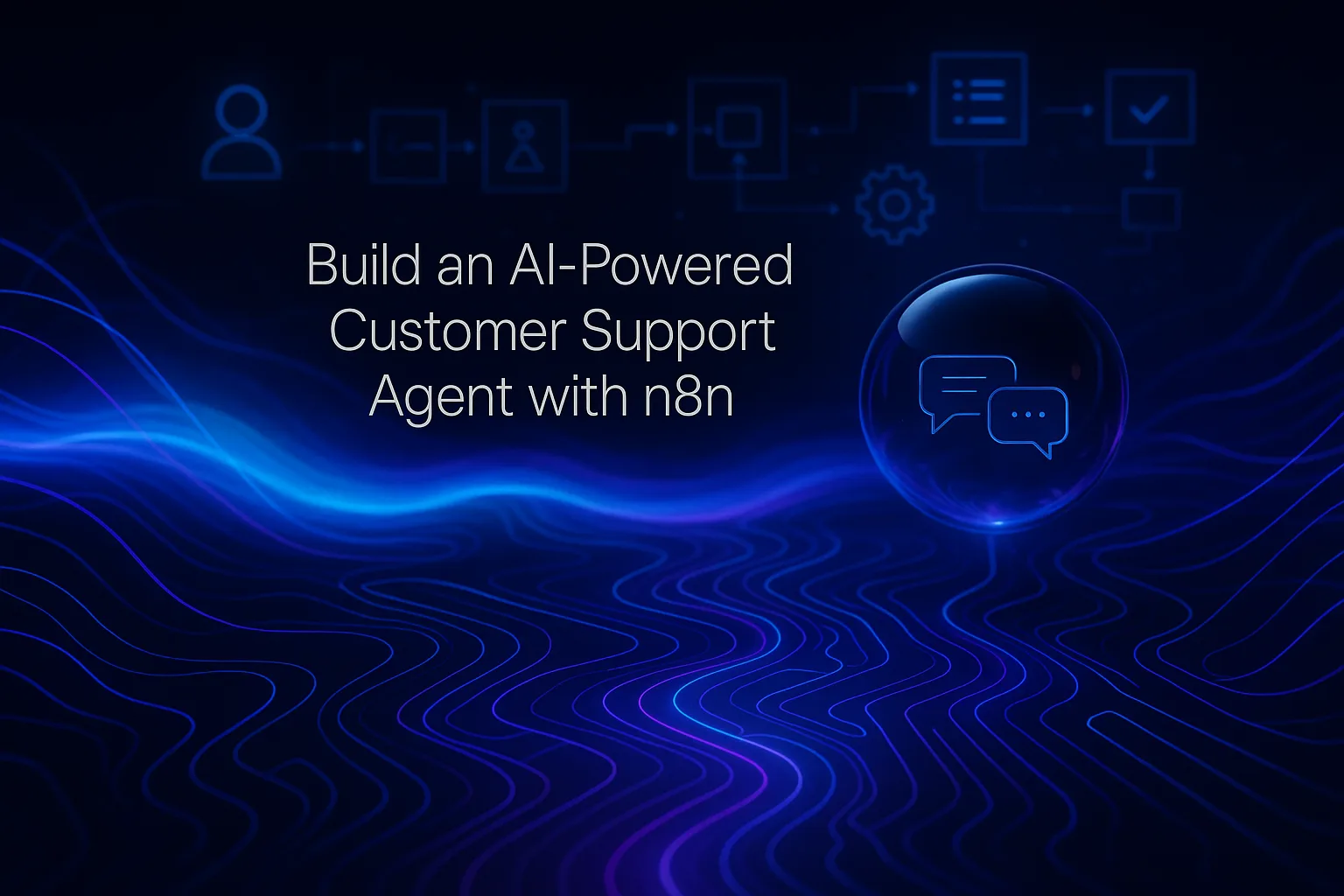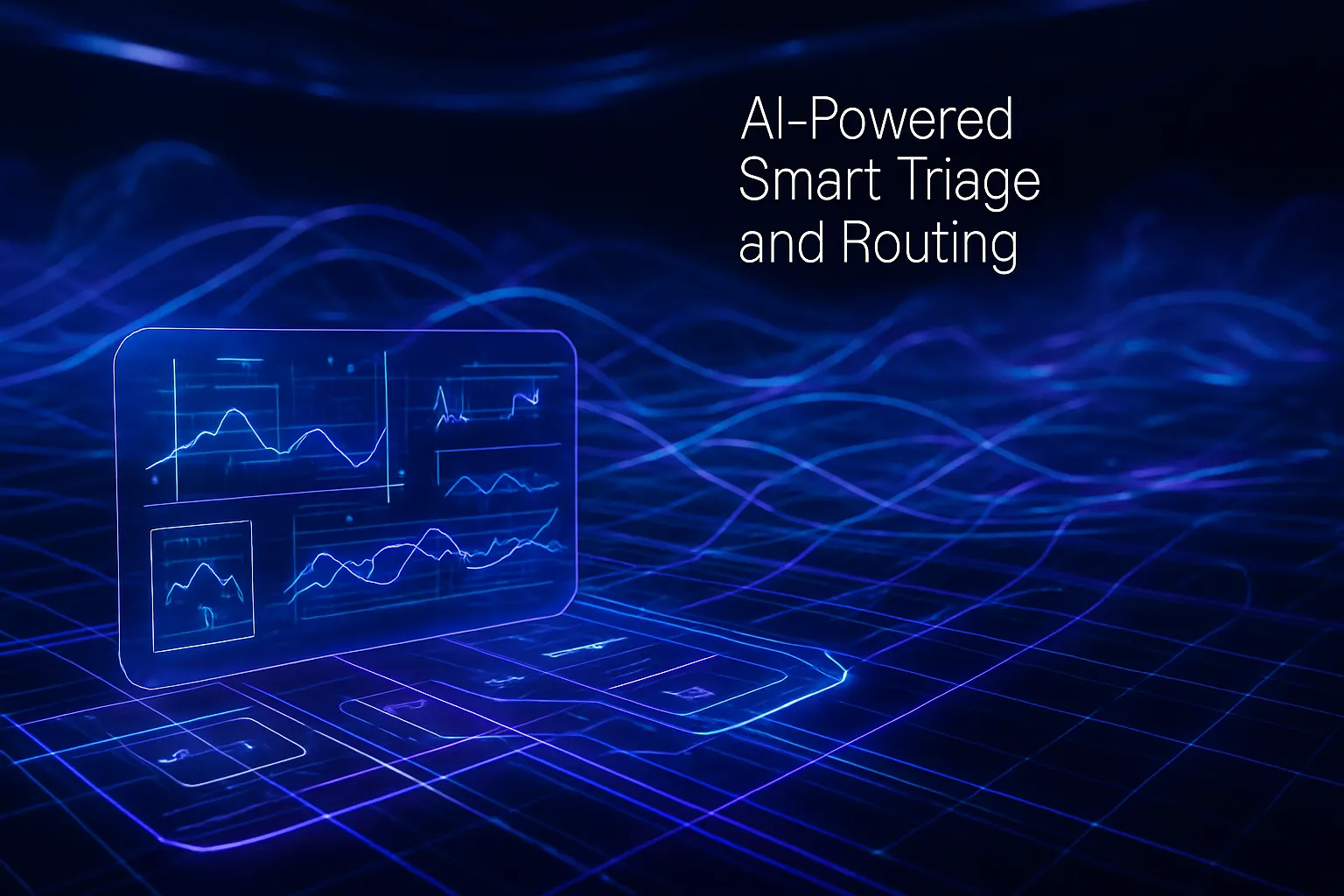Configure an AI Agent in n8n Without Writing a Backend
You can create a highly effective customer support agent directly in n8n, without needing a separate backend system. n8n allows you to connect triggers, logic, and actions using nodes, enabling your agent to read context, reason, and generate replies. It can also execute tasks and escalate to a human when needed.
This guide will walk you through a practical setup. You’ll learn how to map data sources, define customer intents, and incorporate robust guardrails. By following these steps, you will achieve a fully functional agent that integrates seamlessly with your support ecosystem.
The Architecture You Will Assemble
Think in layers, each kept simple and easy to test.
- Entry: Chat widget, email, helpdesk, or API webhook.
- Intent: Classify the customer’s purpose and direct workflow accordingly.
- Context: Retrieve information from your knowledge base.
- Reasoning: Call a Language Model (LLM) with structured prompts.
- Actions: Lookup orders, update tickets, or create returns.
- Response: Compose a reply in your brand’s voice.
- Handoff: Escalate to a human when confidence is low or clarification is needed.
- Logging: Store action histories, metrics, and customer feedback.
n8n acts as the central hub, orchestrating data flows and decision-making across these layers.
Set Up n8n and Your Workspace
- Install n8n either as a self-hosted solution or sign up for the cloud plan.
- Create a dedicated project for support automation.
- Store API keys securely in n8n’s credential management, never in plain text.
- Define environment variables for your Language Model (LLM), vector databases, and CRM systems.
- Set role-based access controls to limit who can view logs and secrets.
Keep the development (dev) and production (prod) environments separated. Export workflows via a version control system for best practices and easy collaboration.
Connect Your Support Stack
Begin with the communication channel your customers use most.
- Helpdesk: Connect using nodes for Zendesk, Freshdesk, or HubSpot Service Hub.
- Chat: Integrate with Intercom, web chat, or Twilio for WhatsApp and SMS.
- Email: Use Gmail or IMAP triggers to manage inbound messages.
- CRM: Incorporate Salesforce or HubSpot for customer and account context.
- Commerce: Leverage Shopify or Stripe for order and payment information.
You can employ a webhook trigger as a universal entry point. Normalize incoming data payloads into a standard schema, ensuring you include key details such as customer ID, channel, locale, and message text.
Design Intents and Conversation State
Define a clear, compact set of intents that are easy for both humans and software to interpret.
- Account help
- Order status
- Shipping issue
- Refund or return
- Product info
- Escalation
Route each intent to a respective sub-workflow. Keep track of the state of the workflow in an easy-to-understand object structure, store keys such as intent, slots, previous_messages, and confidence. Attach this state to the ticket or session to ensure smooth continuity.
Retrieval: Bring Context Before You Generate
Ground every response in your knowledge base. Start with FAQs and policies, then expand to guides, product specifications, and return procedures.
Two Practical Retrieval Paths
- Vector search: Index documents in a vector database using embeddings. Search using both the incoming message and intent.
- Keyword and filters: Query a documentation API with tags, locales, and product IDs for targeted results.
Return the most relevant passages with source citations. For efficiency, cache common answers in n8n’s data store.
Reasoning: Prompts with Consistent Guidance
Use a system prompt that provides guidelines on brand policy and tone. Ensure it is concise. Add retrieved context and examples, and include a checklist to minimize errors.
System: You are a support agent. Follow brand tone: concise, friendly, no emojis.Only use the provided context and ticket data.If unsure, ask for clarification or escalate.Checklist:- Confirm customer identity if needed.- Quote policy if relevant.- Provide next steps and a link.- Offer handoff if confidence is low. Send the customer’s message, intent, retrieved context, and conversation state to the Language Model (LLM). Request a JSON output containing reply, confidence, and actions.
Actions: Enable the Agent to Complete Real Tasks
Map safe actions to explicit workflow nodes. Always specify the actions that the agent can perform, avoiding unstructured or undefined execution.
- Retrieve order details by email and last four digits.
- Create a replacement order within policy parameters.
- Issue a refund under a set amount.
- Schedule a return and generate a prepaid label.
Validate all inputs and permissions within n8n. Document every operation in a human-readable log. Request human approval for actions that exceed predefined limits.
Guardrails to Protect Customers and Teams
- PII control: Mask sensitive values and redact confidential fields.
- Allowlist: Restrict which functions and endpoints can be accessed per intent.
- Rate limits: Impose per-user and per-workflow activity limits.
- Refusal rules: Specify types of questions or topics the agent should not answer.
- Content filters: Block replies that are toxic or unsafe.
Test these guardrails using challenging “adversarial” prompts, and store any failures as fixtures for future regression testing.
Human-in-the-Loop That Feels Natural
Not every customer reply should be sent automatically. Set up a review queue in your helpdesk, responses with low confidence go there first. Human agents can approve, edit, or provide corrective feedback.
Send reviewer notes back to n8n, so the dataset evolves for future improvement. This feedback loop drives ongoing quality gains.
Measure What Matters and Iterate Weekly
- First response time
- Time to resolution
- Deflection and auto-resolve rates
- Customer sentiment or CSAT
- Agent edit distance on AI-generated drafts
Build a reporting dashboard in your BI tool or within n8n itself. Track trends by intent and channel. For a practical example of impact, review how teams boosted customer service efficiency by over 38% using AI. Keep applying rigorous measurement to refine your workflow.
A Reference n8n Workflow You Can Copy
- Trigger: Receive message payload via webhook.
- Normalize: Use a Function node to map input fields to a standard schema.
- Detect language: Set locale and routing using a Language node.
- Classify: Employ an LLM node to determine intent and confidence.
- Retrieve: Use a vector search node to fetch top context passages with sources.
- Decide: If confidence is low, route the case to a human review queue.
- Act: Run authenticated, explicit actions using safe nodes.
- Draft: Leverage an LLM or the Typewise API to draft a brand-consistent reply with full context.
- Guard: Apply content filters and mask personally identifiable information (PII).
- Send: Deliver the response through your helpdesk or chat node.
- Log: Record all events, token usage, and outcomes in a data store.
- Learn: Collect feedback to improve prompts and update examples.
Keep workflow blocks modular. You should be able to swap out any node without causing system-wide issues.
Deployment, Privacy, and Cost Basics
Choose where your data is stored. Self-hosting n8n lets you keep data within your own cloud environment. Use private networks for all vector and database traffic. Minimize log retention and ensure sensitive values are always redacted.
Review vendor and provider terms to ensure regulatory compliance in your region. Address data deletion requests using a dedicated n8n job, and maintain a kill switch to instantly disable the agent if necessary.
Estimate your per-ticket support costs by tallying LLM calls, retrieval operations, and action executions. Add a buffer for retries. Regularly track unit costs, and adjust rate limits or thresholds as needed.
Common Pitfalls and Quick Fixes
- Hallucinated facts: Supply more context passages and define strict refusal rules for uncertain topics.
- Overly long replies: Constrain output length and provide clear style examples.
- Incorrect actions: Mandate explicit “slot” checks before executing any workflow.
- Locale and language mismatches: Detect and handle language at the earliest possible step.
- Unreliable APIs: Build in retries with jitter and use circuit breakers for stability.
- Prompt drift: Make periodic snapshots of the prompts and conduct weekly tests with a consistent set of parameters.
Ready to Ship an Agent Your Team Trusts?
Building your own AI customer support agent with n8n is a great way to get started and experiment with automation. But when you’re ready to scale and need enterprise-level performance, security, and brand consistency, consider Typewise. It’s a purpose-built AI customer service solution that goes beyond DIY setups, helping you deliver faster, smarter, and more reliable support.
FAQ
How can n8n help construct a customer support AI without a backend?
n8n allows seamless integration of various workflows using nodes, which means you can design a support AI to handle everything from inquiries to escalations without needing a separate backend infrastructure. This means bypassing the complexities and maintenance hassles of a traditional backend.
What are the key layers in setting up a support agent in n8n?
The architecture is divided into simple layers: entry, intent, context, reasoning, actions, response, handoff, and logging. This structured approach simplifies troubleshooting but be wary of potential bottlenecks if layers are poorly configured.
Why is it important to keep development and production environments separate in n8n?
Separating environments ensures that testing and changes can be done without affecting live operations, reducing the risk of deploying untested workflows. It also streamlines debugging and version control practices, essential for maintaining operational integrity.
What strategies can be implemented to ground agent responses effectively?
Utilizing both vector searches and keyword filters helps in retrieving context-rich responses, but they must be regularly updated and expanded. Static databases can limit the AI’s ability to respond accurately to evolving customer scenarios.
How do you ensure the AI does not perform unauthorized actions?
Restrict actions to pre-defined nodes, ensuring every operation is secure and traceable. Inputs should be validated, and sensitive actions should always require manual approval to prevent accidental breaches or unauthorized manipulations.
What role do guardrails play in deploying an AI support agent?
Guardrails protect both the users and your system by imposing limits, such as rate restrictions and refusal rules, making the AI's operations predictable and safe. Ignoring these can lead to erratic behavior and potential security issues.
Why is a 'human-in-the-loop' approach recommended for AI replies?
Human oversight ensures that low-confidence AI responses are vetted before sending, maintaining the quality and accuracy of customer interactions. Dependence solely on AI without this filter can lead to brand-damaging miscommunications.
How can the success of an AI agent be practically measured?
Metrics like time to resolution, deflection rates, and edit distances from generated drafts indicate efficiency and accuracy. Quantifying these elements avoids misleading assumptions about AI performance and directs necessary improvements.
What are common pitfalls in deploying an AI support agent with n8n?
A common issue is “hallucinated” facts due to insufficient grounding. Robust context retrieval and regular prompt testing mitigate these risks, but neglecting them can lead to losing customer trust.






